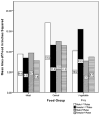Using plate mapping to examine sensitivity to plate size in food portions and meal composition among college students
- PMID: 22867909
- PMCID: PMC4441264
- DOI: 10.1016/j.appet.2012.07.020
Using plate mapping to examine sensitivity to plate size in food portions and meal composition among college students
Abstract
People eat meals rather than nutrients or food groups. Plate size may influence meal size, meal composition, and food type. To examine effects of plate size on meals, we developed a method we label plate mapping. A quasi-experimental study asked university students to accurately draw what they would like to eat for dinner on either a 9″ or 11″ paper plate. Coding plate drawings for total meal size revealed that students drew an average of 26% more food on larger plates. When plates were coded for meal composition we found that the biggest three food portions drawn by students were bigger on 11″ plates, with 70% of the overall difference in food area occurring in the biggest food. Participants drew bigger portions of vegetables on larger plates, while other food types showed little change in mean size. Gender moderated plate sensitivity for food types: women drew 36% bigger vegetable portions than men on larger plates. Smaller plates may lead to smaller meal sizes, but plate size may differentially influence composition of meals for men and women. These findings suggest plate mapping can be used to reflect meal conceptualizations and assess sensitivity to plate size.
Copyright © 2012 Elsevier Ltd. All rights reserved.
Figures
Similar articles
-
Do Adults Draw Differently-Sized Meals on Larger or Smaller Plates? Examining Plate Size in a Community Sample.Food Qual Prefer. 2019 Jun;74:72-77. doi: 10.1016/j.foodqual.2019.01.012. Epub 2019 Jan 17. Food Qual Prefer. 2019. PMID: 31662598 Free PMC article.
-
Using plate mapping to examine portion size and plate composition for large and small divided plates.Eat Behav. 2014 Dec;15(4):658-63. doi: 10.1016/j.eatbeh.2014.08.022. Epub 2014 Sep 16. Eat Behav. 2014. PMID: 25280373 Free PMC article.
-
Validating the plate mapping method: Comparing drawn foods and actual foods of university students in a cafeteria.Appetite. 2016 May 1;100:197-202. doi: 10.1016/j.appet.2016.02.023. Epub 2016 Feb 16. Appetite. 2016. PMID: 26896836
-
Draw Your Dinner: A Longitudinal Study of Perceptions of Meal Size with Different Plate Sizes.Am J Health Behav. 2019 May 1;43(3):621-634. doi: 10.5993/AJHB.43.3.15. Am J Health Behav. 2019. PMID: 31046891
-
The influence of plate size on meal composition. Literature review and experiment.Appetite. 2014 Nov;82:91-6. doi: 10.1016/j.appet.2014.07.010. Epub 2014 Jul 15. Appetite. 2014. PMID: 25049139 Review.
Cited by
-
Association between Platescapes, Foodscapes, and Meal Energy Intake in Government Employees from Muar, Johor, Malaysia.Nutrients. 2018 Jun 25;10(7):819. doi: 10.3390/nu10070819. Nutrients. 2018. PMID: 29941848 Free PMC article.
-
Visual Cues and Food Intake: Distortion Power of Plate and Spoon Size on Overweight and Obese University Staff.Int J Prev Med. 2019 May 17;10:82. doi: 10.4103/ijpvm.IJPVM_557_17. eCollection 2019. Int J Prev Med. 2019. PMID: 31198517 Free PMC article.
-
Do Adults Draw Differently-Sized Meals on Larger or Smaller Plates? Examining Plate Size in a Community Sample.Food Qual Prefer. 2019 Jun;74:72-77. doi: 10.1016/j.foodqual.2019.01.012. Epub 2019 Jan 17. Food Qual Prefer. 2019. PMID: 31662598 Free PMC article.
-
Using plate mapping to examine portion size and plate composition for large and small divided plates.Eat Behav. 2014 Dec;15(4):658-63. doi: 10.1016/j.eatbeh.2014.08.022. Epub 2014 Sep 16. Eat Behav. 2014. PMID: 25280373 Free PMC article.
-
The Influence of Portion Size and Timing of Meals on Weight Balance and Obesity.Curr Obes Rep. 2015 Mar;4(1):11-8. doi: 10.1007/s13679-015-0138-y. Curr Obes Rep. 2015. PMID: 26627086 Review.
References
-
- Bolland JE, Ward JY, Bolland TW. Improved accuracy of estimating food quantities up to 4 weeks after training. Journal of American Dietetic Association. 1990;90(10):1402–1404. 1407. - PubMed
-
- Bolland JE, Yuhas JA, Bolland TW. Estimation of food portion sizes: effectiveness of training. Journal of American Dietetic Association. 1988;88(7):817–821. - PubMed
-
- Brendl CM, Markman AB, Messner C. The Devaluation Effect: Activating a Need Devalues Unrelated Objects. Journal of Consumer Research. 2003;29(4):463–473.
-
- Bruner JS, Goodman CC. Value and need as organizing factors in perception. Journal of Abnormal Psychology. 1947;42(1):33–44. - PubMed
-
- Bruner JS, Postman L. Symbolic value as an organizing factor in perception. Journal of Social Psychology. 1948;27(2):203–208. - PubMed
Publication types
MeSH terms
Grants and funding
LinkOut - more resources
Full Text Sources


